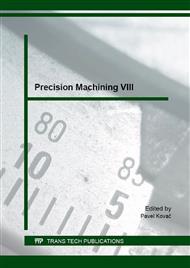[1]
P. Kopacek, Intelligent Manufacturing: Present State and Future Trends, Journal of Intelligent and Robotic Systems, Volume 26 (1999), pp: 217-229.
Google Scholar
[2]
ISO/DIS 9001: 2014: Quality management systems - Requirements.
Google Scholar
[3]
EN/ISO 9004: 2009: Managing for the sustained success of an organization - A quality management approach.
Google Scholar
[4]
ISO/DIS 14001: 2014: Environmental management systems - Requirements with guidance for use.
Google Scholar
[5]
ISO 50001: 2011: Energy management systems - Requirements with guidance for use.
Google Scholar
[6]
M.N. Durakbasa, P.H. Osanna, Quality in Industry, Department for Interchangeable Manufacturing and. Industrial Metrology, Vienna University of Technology, Vienna, (2009).
Google Scholar
[7]
R.K. Leach. R. Boyd, T. Burke, H.U. Danzebrink, K. Dirscherl., T. Dziomba, M. Gee, L. Koenders, V. Morazzani, A. Pidduck, D. Roy, W.E.S. Unger, A. Yacoot, The European nanometrology landscape. Nanotechnology, Volume 22, Number 6, (2011).
DOI: 10.1088/0957-4484/22/6/062001
Google Scholar
[8]
C. Felho, B. Karpuschewski, J. Kundrak, Surface Roughness Modelling in Face Milling, Procedia CIRP, Volume 31 (2015), p. pp.136-141.
DOI: 10.1016/j.procir.2015.03.075
Google Scholar
[9]
G. Varga, J. Kundrák, Effect of environmentally conscious machining on machined surface quality, Applied Mechanics and Materials, Volume 309 (2013), pp.35-42.
DOI: 10.4028/www.scientific.net/amm.309.35
Google Scholar
[10]
G. Krolczyk, , S. Legutko, Investigations into Surface Integrity in the Turning Process of Duplex Stainless Steel. Transactions of FAMENA, Volume 38 (2014), pp: 77-82.
Google Scholar
[11]
G. Krolczyk, S. Legutko, Experimental analysis by measurement of surface roughness variations in turning process of duplex stainless steel. Metrology and Measurement Systems, Volume 21 (2014), pp: 759-770.
DOI: 10.2478/mms-2014-0060
Google Scholar
[12]
S. Wojciechowski, P. Twardowski, M. Wieczorowski, Surface texture analysis after ball end milling with various surface inclination of hardened steel, Metrology and Measurement Systems, Volume 21, (2014), pp: 145-156.
DOI: 10.2478/mms-2014-0014
Google Scholar
[13]
L.A. Zadeh, Outline of a new approach to the analysis of complex systems and decision processes. Systems, Man and Cybernetics, IEEE Transactions on, Volume 1 (1973), pp: 28-44.
DOI: 10.1109/tsmc.1973.5408575
Google Scholar
[14]
L.A. Zadeh, Fuzzy sets. Information and control, Volume 8 (1965), pp: 338-353.
Google Scholar
[15]
M.N. Durakbasa, P.H. Osanna, J.M. Bauer, G. Bas, Innovation In Production Metrology For Precision Engineering And To Support Sustainability And Improvement Of Process And Product Quality In Modern Manufacturing Industry, MSD Journal, Volume 4 (2012).
Google Scholar


